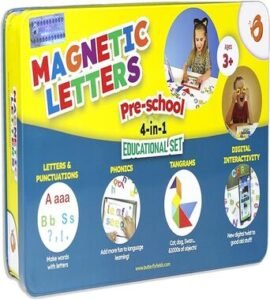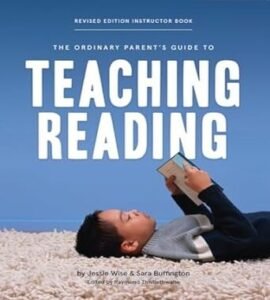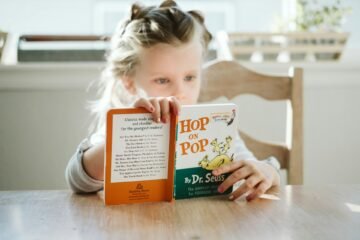Are you trying to find the best phonics books for kindergarten and younger students? Then you are most likely a parent or teacher seeking for the greatest tools to simplify your job. Phonics is a body of information and skills explaining how the alphabet works. To properly read and make the connection between reading and writing, you must have this understanding. However, with the dynamics of the world changing, there are now demands and a need for new instructional strategies, particularly regarding writing and reading.
What is phonics?
Phonics teaches children how to read by decoding sounds into letters. This is done through learning how to read words one letter at a time, and it starts very early in life.
For reading and writing, phonics relates specific sounds to each letter or alphabet. English has various sounds for each letter of the alphabet. To take the first step towards reading, one must learn to recognize the alphabet and its sounds.
The most important thing to remember about phonics is that it’s not just a matter of reading words but also about learning to sound out words. Kids can build up their vocabulary and improve their pronunciation by sounding out words.
Another thing you need to remember when teaching phonics is that it should be fun for kids. When they enjoy their work, they’re more likely to learn quickly and retain information.
Why should children learn phonics?
Kids must learn to read and write, as we can all agree. Children who learn phonics are better able to recognize unfamiliar words. Children must read the words and phrases even as they learn to recognize the alphabet. The two years of kindergarten are when all of this is anticipated.
Keep in mind that in grade 1, students must read short sentences. Phonics books for preschoolers and kindergarten students can make the teaching-learning process enjoyable for your students. You can introduce uncomplicated phonic reader storybooks with straightforward words that children can quickly recognize as they learn phonics. Yes, the teaching-learning process does not have to be difficult for the children or the parent/teacher, therefore remains composed.
Are phonics books required for readers in kindergarten and preschool?
Yes, many younger parents are concerned about their children’s (ages 3 to 6) ability to read and write in the unpredictably pandemic environment. So why not add to your child’s education by having enjoyable reading and phonics practice sessions at home?
We train adults to read and write, but for young children in preschool and kindergarten, recognizing alphabets and sounds is a foreign concept. Keep in mind that children in nursery and kindergarten learn by regularly reading and sounding out alphabets.
What do we mean when we say “Easy Phonics Readers”?
Storybooks that help readers recognize words by their phonics are known as easy phonics readers. These books concentrate on words that use certain particular phonic repetitions. This aids in recalling and remembering the relationship between letters and sounds in different words. The phonics books are also simple to decode and read.
The “whole language” method is used in the other type of easy readers, where the vocabulary is natural, and there is little emphasis on phonic recognition. In the “whole language” method of teaching children to read, words are recognized by guesswork, sight words, or memorization of spellings. Both the youngster and the parent or instructor may become exhausted and frustrated by this.
Best phonics books for kindergarten and preschool
If you are looking for the best phonics books for kindergarten and preschool, check out these selections:
1. My First Library of Learning

This is the most recent and comprehensive box set collection (of ten early learning board books) for children in playschool, kindergarten, and nursery. Publisher Puffin Publications is in charge of it (Penguin). Kids from 2.5 to 6 years old will benefit from this set.
Every volume of the strong page board book is devoted to fundamental subjects, including alphabets, colors, numbers, animals, opposites, things-at-home, transportation, etc. These books are appealing and entertaining thanks to the series’ meticulous research and well-designed, brightly colored illustrations.
It covers fundamental ideas suitable for young children’s ages, helping to expand their general knowledge and vocabulary while educating them. To help the youngster connect the material in the books to their environment, you could show ideas (like opposites) or objects (like transportation). This will increase the child’s general knowledge foundation and support their learning journey as they gradually learn additional material.

For children between the ages of 2.5 and 6, this package of 10 board books is well-liked. Thus, these board books will be beneficial to children from early childhood until they enter grade 1. Wonder House Books handles the books’ publication. The board books are appealing and sturdily constructed thanks to their thick, brightly colored pages. Young early learners will benefit from the topics’ in-depth study and age-appropriate presentation.
This box set covers every basic concept, including colors, alphabets, numbers, transportation, wild creatures, etc. Picture talk and regular word sounding help the children connect the words well with visuals and their context. The child’s environment can correlate with the book’s concepts.
3. Picture Talk and Conversation
 The target audience for this book is children between the ages of 2 and 6. Parents or teachers can use this book to discuss common objects, animals, locations, people, and activities around us. Children become accustomed to their surroundings, learn communication skills, and comprehensively understand their surroundings.
The target audience for this book is children between the ages of 2 and 6. Parents or teachers can use this book to discuss common objects, animals, locations, people, and activities around us. Children become accustomed to their surroundings, learn communication skills, and comprehensively understand their surroundings.
The young students are given prior knowledge about a range of topics so that later, when learning something new, they may relate it to what they already know. Children can’t really read or write words or phrases when they are as young as 2 to 6 years old. Because of this, picture talk is a helpful teaching method when introducing literacy and awareness. This book is part of a Jolly Kids series, a respected source for teaching professionals.
4. My First Book of Phonics Words
 The Sheth Publishing House Jolly Kids book series includes this title. It offers the solution of matching letters to sounds. Using this book to educate your child to read patiently can help them become more confident readers. Not only can we teach the letter sounds but also how to combine the sounds of the letters. This book includes phonics for kindergarten students, as well as word construction and sight words.
The Sheth Publishing House Jolly Kids book series includes this title. It offers the solution of matching letters to sounds. Using this book to educate your child to read patiently can help them become more confident readers. Not only can we teach the letter sounds but also how to combine the sounds of the letters. This book includes phonics for kindergarten students, as well as word construction and sight words.
5. Magnetic Letters And Number Board for Kids

Butterfly Edufields produces these magnetic letters, numbers, and phonics play-way learning tools and comes with a magnetic board. As many kids learn by physically doing things, kinesthetic learning is among the learning methods. By selecting the letters by hand, kindergarten students can learn by doing while improving their hand-eye coordination and motor abilities.
Kids learn to pay attention and recognize the letters as they hear the phonic sounds of sentences and alphabets. Through daily utilization of this activity box, children will gradually learn the spellings of words with three to five letters.
6. Learn to Read: A Magical Sight Words and Phonics Activity Workbook

Kids of any age who wish to improve their reading and writing skills pleasantly and magically should read this book! There are over 40 sight words in the book that children learn visually rather than phonetically. It is considerably simpler to learn other terms because these tones make up over half of most children’s books. There are word recognition exercises and entertaining games and puzzles featuring mythical creatures like unicorns, dinosaurs, and mermaids.
7. First Little Readers Parent Pack: Guided Reading Level D

Start reading more effectively with this extensive collection of 25 inspiring picture books associated with Guided Reading Level D. Between two and four lines of content per page, basic text, easily decodable vocabulary, and strong pictorial cues are all elements of the books that help readers with limited reading experience. With these humorous books about their favorite subjects, including dogs, dinosaurs, princesses, and pizza, kids will smile, learn, and gain confidence accompanying 4-page parent guide.
 Thousands of parents and teachers have gravitated to Jim Trelease’s cherished classic for over three decades to assist countless children in becoming keen readers by igniting their imaginations and developing their language skills after “Dear Abby” recommended it upon its initial publication in 1982. It has long been a requirement in education programs for aspiring teachers.
Thousands of parents and teachers have gravitated to Jim Trelease’s cherished classic for over three decades to assist countless children in becoming keen readers by igniting their imaginations and developing their language skills after “Dear Abby” recommended it upon its initial publication in 1982. It has long been a requirement in education programs for aspiring teachers.
This revised version of The Read-Aloud Handbook addresses the advantages, incentives, and significance of reading aloud to today’s youth. The Read-Aloud Handbook provides tried-and-true methods and approaches for encouraging kids to enjoy reading and putting them on the path to becoming proficient readers. It is supported by fascinating anecdotes besides the most recent research (along with the bad and good news about digital learning).
9. The Ordinary Parent’s Guide to Teaching Reading
 Too many parents observe their kids having difficulty with early reading abilities while being clueless about how to assist. Too frequently, phonics programs are convoluted, exorbitantly expensive, and gimmicky. The Ordinary Parent’s Guide to Teaching Reading cuts through the confusion and provides parents with a clear, step-by-step manual for teaching reading. Everything parents require is contained in this single book.
Too many parents observe their kids having difficulty with early reading abilities while being clueless about how to assist. Too frequently, phonics programs are convoluted, exorbitantly expensive, and gimmicky. The Ordinary Parent’s Guide to Teaching Reading cuts through the confusion and provides parents with a clear, step-by-step manual for teaching reading. Everything parents require is contained in this single book.
10. There’s a Wocket in my Pocket

Part of HarperCollins’ extensive Dr. Seuss rebranding initiative is this lovely book in the second stage. In August 2003, ten more books were released for a second time, including classics like Mr. Brown Can Moo, How the Grinch Stole Christmas and Dr. Seuss’ Sleep Book have colorful covers that include crucial reading level advice: Young children should read Blue Back Books with their parents, beginning readers should work on Green Bank Books through their own, and proficient readers should enjoy Yellow Back Books. It is part of the Blue Back Book series. There’s a Wocket in My Pocket!
Educational benefits of phonics books
There are many educational benefits to having children learn how to read through phonics, such as:
1. Better reading skills—Phonics books help children develop better reading skills, which can help them achieve greater success in school.
2. Improved vocabulary acquisition—Children are more likely to learn unfamiliar words and improve their vocabulary abilities by learning how to read using phonics.
3. Increased comprehension—When readers understand what they are reading, they are more likely to comprehend the material and keep it longer.
4. Enhanced concentration—When children can focus on what they are reading, it can hReading Head Start Review 2023: Everything you Need to Know!elp them become more engaged in their education and tasks.
5. Reduced stress and anxiety—Learning to read can be a daunting task for some children, but having phonics books available can help reduce the stress or anxiety they experience.
Conclusion
Phonics books are a valuable resource for children who want to learn how to read. They provide the foundation for reading success and can help improve a child’s vocabulary and comprehension skills. Phonics books can help children to focus and concentrate on their reading, which can lead to improved reading comprehension.
By providing children with the tools they need to learn how to read effectively, phonics books can help foster a lifelong love of reading. So, if you’re looking for something special to give your child, consider choosing a phonics book as a suitable present.



0 Comments